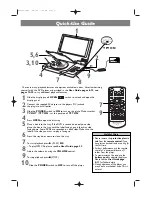
10
OPM-103
REV B
1. Remove watches, rings, and other metal objects.
2. Use tools with insulated handles.
3. Check both the battery cable ends and the battery posts to be
sure they are free of corrosion.
4. Always connect the battery positive cable first and then connect
the battery negative cable. When removing the battery cables
from the battery, reverse the procedure, disconnect the negative
first and then the positive cable.
5. Be sure all connections are tight and coat the terminals and cable
ends with dialectic grease.
WARNING:
The electrolyte is diluted sulfuric acid that is harmful to the skin
and eyes. It is electrically conductive and corrosive. The following
precautions must always be taken.
1. Always wear full eye protection and protective clothing.
2. Where electrolyte contacts skin, wash off immediately with water.
3. If electrolyte contacts the eyes, flush thoroughly and immediately
with water and seek immediate medical attention
4. Spilled electrolyte is to be washed down with an acid neutralizing
agent. A common practice is to use a solution of one pound
of bicarbonate of soda (baking soda) to one gallon of water.
The bicarbonate of soda solution is to be added until the evidence
of reaction (foaming) has ceased. The resulting liquid is to be
flushed with water and the area dried.
DANGER: EXPLOSIVE FIRE RISK:
1. Never smoke when near batteries.
2. Do not cause a flame or spark in the battery area.
3. Always discharge static electricity from your body before touching
batteries by first touching a ground metal surface.
SERVICING BATTERIES
Batteries used on these units may, over time, lose water. This is
especially true if you are using a trickle charger to maintain your
battery. When refilling the battery with water, use only distilled water.
Tap water will shorten the service life of the battery.
Never fill the battery above the fill line. Over filling above the upper
level line may cause the electrolyte to overflow, resulting in corrosion to
the engine or nearby parts. Immediately wash off any spilled electrolyte
following the procedure above.
NOTE:
Always make sure that a new battery is fully charged before
installing it on a generator set. Failure to do so can cause damage to
the engine control module in the generator set.
All connections must be clean and tight. Check the electrolyte in the
battery periodically to be sure it is above the plates. Never allow the
battery to remain in a discharged condition.
A.C. ELECTRICAL CONNECTIONS
NOTICE: CLASS 1 WIRING METHODS ARE TO BE USED FOR ALL
FIELD WIRING CONNECTIONS TO TERMINALS OF A CLASS 2
CIRCUIT
NOTE: The symbol always indicates ground where shown. All
wiring must be completed in accordance with the National Electric
Code as well as any state and local codes.
You must pay particular attention to wire size requirement for
the amperage of service you are dealing with. The table below
provides you guidance on wire sizing based on both wire type and
amperage.
Wire amperages have been derated for 40° C ambient
temperatures operation.
WARNING:
A mainline circuit breaker has been provided inside the generator
housing. During all wiring installations, make sure the breaker is in the
OFF position and the generator start battery is disconnected.
NEUTRAL LUGS
Each DE unit comes with a neutral lug from the factory to provide
a connection point from the generator to the transfer switch or load
distribution center.
The generator ships from the factory with a
bonded neutral.
Model
Lug AMP
Wire Capability
Torque
DE20
100
#12 AWG to #1/10 AWG
50 in. lbs.
DE30 - DE90
225
#4 AWG to 300 MCM
250 in. lbs.
GROUND LUG
Ground lugs are provided to connect to the distribution center.
The
Generator ships from the factory with a bonded neutral.
Model
Wire Capability
Torque
DE20 - DE30
#10 AWG to 2/0 AWG
200 in. lbs.
DE45 - DE90
#6 AWG to 300 MCM
250 in. lbs.
WARNING: PERSONAL DANGER:
These units are shipped with a NEUTRAL TO GROUND BOND
INSTALLED. If your system already has a neutral to ground bond, then
you must run a separate ground lead to that location and UNBOND
THE JUMPER IN THE CONNECTION PANEL. For additional
information, refer to the current National Electrical Code on grounding.
WARNING: EQUIPMENT DAMAGE:
When installing a three phase 240 Volt system, be sure you know
which lead is high voltage ‘wild’ leg (208 Volt to neutral). The generator
normally carries the high voltage on the G2 lead.






































